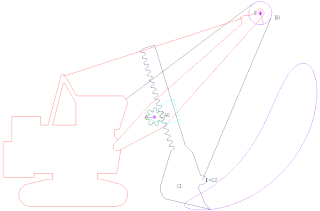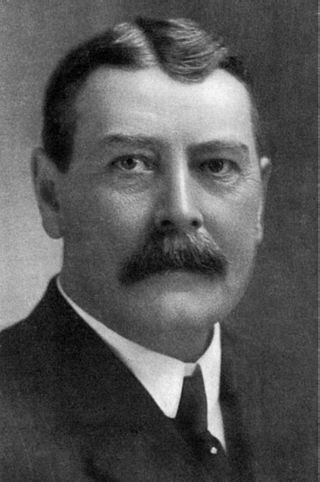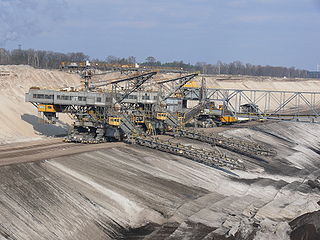
Excavators are heavy construction equipment primarily consisting of a boom, dipper, bucket and cab on a rotating platform known as the "house" - although the largest form ever, the dragline excavator, eliminated the dipper in favor of a line and winch.

A dragline excavator is a heavy-duty excavator used in civil engineering and surface mining. It was invented in 1904, and presented an immediate challenge to the steam shovel and its diesel and electric powered descendant, the power shovel. Much more efficient than even the largest of the latter, it enjoyed a heyday in extreme size for most of the 20th century, first becoming challenged by more efficient rotary excavators in the 1950s, then superseded by them on the upper end from the 1970s on.

A reclaimer is a large machine used in bulk material handling applications. A reclaimer's function is to recover bulk material such as ores and cereals from a stockpile. A stacker is used to stack the material.

Bagger 288, previously known as the MAN TAKRAF RB288 built by the German company Krupp for the energy and mining firm Rheinbraun, is a bucket-wheel excavator or mobile strip mining machine.

A bucket-wheel excavator (BWE) is a large heavy equipment machine used in surface mining.

Big Muskie was a dragline excavator built by Bucyrus-Erie and owned by the Central Ohio Coal Company, weighing 13,500 short tons (12,200 t) and standing nearly 22 stories tall. It mined coal in the U.S. state of Ohio from 1969 to 1991. It was dismantled and sold for scrap in 1999.

A landship is a large land vehicle that travels exclusively on land. Its name is meant to distinguish it from vehicles that travel through other mediums such as conventional ships, airships, and spaceships.

A power shovel, also known as a motor shovel, stripping shovel, front shovel, mining shovel or rope shovel, is a bucket-equipped machine usually powered by steam, diesel fuel, gasoline or electricity and used for digging and loading earth or fragmented rock and for mineral extraction. Power shovels are a type of rope/cable excavator, where the digging arm is controlled and powered by winches and steel ropes, rather than hydraulics like in the modern hydraulic excavators. Basic parts of a power shovel include the track system, cabin, cables, rack, stick, boom foot-pin, saddle block, boom, boom point sheaves and bucket. The size of bucket varies from 0.73 to 53 cubic meters.
TAKRAF Group (“TAKRAF”), is a global German industrial company. Through its brands, TAKRAF and DELKOR, the Group provides equipment, systems and services to the mining and associated industries.

F60 is the series designation of five overburden conveyor bridges used in brown coal (lignite) opencast mining in the Lusatian coalfields in Germany. They were built by the former Volkseigener Betrieb TAKRAF in Lauchhammer and are the largest movable technical industrial machines in the world. As overburden conveyor bridges, they transport the overburden which lies over the coal seam. The cutting height is 60 m (200 ft), hence the name F60. In total, the F60 is up to 80 m (260 ft) high and 240 m (790 ft) wide; with a length of 502 m (1,647 ft), it is described as the lying Eiffel Tower, making these behemoths not only the longest vehicle ever made—beating Prelude FLNG, the longest ship—but the largest vehicle by physical dimensions ever made by humankind. In operating condition, it weighs 13,600 metric tons making the F60 also one of the heaviest land vehicles ever made, beaten only by Bagger 293, which is a giant bucket-wheel excavator. Nevertheless, despite its immense size, it is operated by only a crew of 14.
A bucket is a specialized container attached to a machine, as compared to a bucket adapted for manual use by a human being. It is a bulk material handling component.

P&H Mining Equipment sells drilling and material handling machinery under the "P&H" trademark. The firm is an operating subsidiary of Joy Global Inc. In 2017 Joy Global Inc. was acquired by Komatsu Limited of Tokyo, Japan, and is now known as Komatsu Mining Corporation and operates as a subsidiary of Komatsu.

Joy Global Inc. was a company that manufactured and serviced heavy equipment used in the extraction and haulage of coal and minerals in both underground and surface mining. The company had manufacturing facilities in Alabama, Pennsylvania, Texas, Wisconsin, Australia, Canada, China, France, South Africa, Poland and the United Kingdom. In 2017, Joy Global was acquired by Komatsu Limited and was renamed Komatsu Mining Corp.

Spreaders in mining are heavy equipment used in surface mining and mechanical engineering/civil engineering. The primary function of a spreader is to act as a continuous spreading machine in large-scale open pit mining operations.

TAKRAF India Private Limited is a wholly owned subsidiary of TAKRAF GmbH. As with its parent company, TAKRAF India provides equipment, systems and services to the mining and associated industries through the TAKRAF and DELKOR brands.

Nettle Creek Tin Dredge is a heritage-listed dredge at Nettle Creek, Innot Hot Springs, Tablelands Region, Queensland, Australia. It was built in 1957. It is also known as Barrytown 2 Dredge, Barrytown Gold Dredge, and Battle Creek Tin Dredge. It was added to the Queensland Heritage Register on 22 September 1995.
A conveyor bridge is a piece of mining equipment used in strip mining for the removal of overburden and for dumping it on the inner spoil bank of the open-cut mine. It is used together with multibucket excavators, frequently bucket chain excavators, that remove the overburden which is moved to the bridge by connecting conveyors. Conveyor bridges are used in working horizontally layered deposits with soft overburden rock in areas where mean annual temperatures are above freezing. They are frequently used in lignite mining.

The Type SRs 8000 or less commonly known as the SRs 8000-class, is a family of bucket-wheel excavators known for being one of the largest terrestrial vehicles ever made by man, with Bagger 293 its - "lead vessel" - being the largest ground vehicle in history. The Type SRs 8000 classification was coined by TAKRAF to describe specifically, Bagger 293, although it is unclear if this extends to its other "sibling vehicles" within the same bulk.

The Type Es 3750 or simply the Es 3750 is a series of bucket chain excavators built by TAKRAF and used in Germany. According to TAKRAF, they boast that the Type Es 3750 is the largest bucket chain excavators in the world. Type Es 3750s are notable for being always used in conjunction with the Overburden Conveyor Bridge F60, another absurdly large land vehicle.

The Type SRs 2000 is a class of medium-sized bucket-wheel excavators built by TAKRAF. It is by far, one of the most common and recognizable BWEs built and sold by TAKRAF, with 56 Type SRs 2000s being commissioned and launched as of 2013.




















